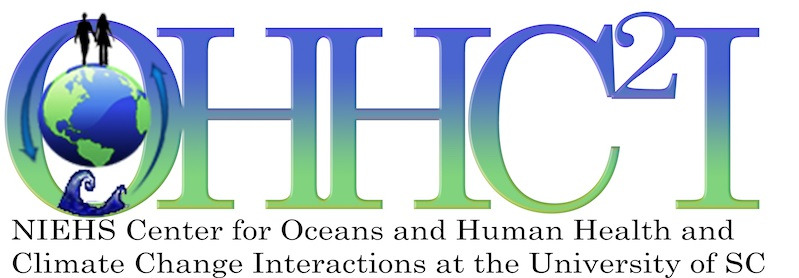Located at the University of South Carolina, OHHC2I is a vibrant research partnerships with The College of Charleston, Baylor University, The Citadel, Rutgers University, and the University of Maryland’s Environmental Science Center. In addition, OHHC2I has established research collaborations with the National Oceanic and Atmospheric Administration, the United States Geological Survey, the Interstate Shellfish Sanitation Program, and the Low Country Alliance for Model Community. The goal of OHHC2I is to enhance our knowledge of the roles climate change may play in affecting Vibrio bacterial infections and production of toxins from freshwater cyanobacteria, and their resulting effects on ecosystem and human health.
About the OHHC2I
Research conducted at the OHHC2I Center is focused on development of tools to detect and assess the health risks
associated with these bacterial and harmful algal blooms (HABs) microorganisms and
to also better understand their interactions with microplastics in both freshwater
and coastal waters. Vibrio bacteria occur naturally in coastal and ocean waters, and Vibrio infections are the leading cause of death from seafood consumption in the U.S. In
addition, serious wound infections also occasionally result from recreational contact
with contaminated waters. The toxins from certain cyanobacteria are the most frequently
detected harmful algal toxins in U.S. waters and occur mostly in freshwater but also
may be carried into or grow in coastal brackish water areas as well affecting seafood
safety and contact recreation.
Because of the breadth of health threats from these kinds of microorganisms and the likelihood that climate change may increase health risks associated with them, the Center is undertaking four highly collaborative and integrated research projects (Vibrio Bacteria, Cyanobacteria, Chemistry and Toxicology) to examine how climate change may affect them.
Ourmulti-factorial design is examining how changes in temperature, salinity, and pH associated with climate change and gradients of nutrients (nitrogen and phosphorous) will affect changes in virulence and antibiotic resistance in Vibrio vulnificus and V. parahaemolyticus and cause increased growth, bloom and toxin production in selected cyanobacteria (Microcystin aeruginosa, Cylindrospermopsis raciborkii and Anaebaena flor-aquae).
Researchers are also assessing the individual and cumulative effects of highly virulent Vibrio bacteria, microcystin toxins, and microplastics (a Contaminant of Emerging Concern) on mammalian exposure models, studying effects on critical organs, inflammation, and specific health problems like non-alcoholic liver disease, the gut microbiome and inflammasome in mammals. Sediment cores from lake bottoms are being analyzed for relic levels of cyanobacterial toxins and nutrients which is being dated using radio-isotopes for comparison with historical changes associated with climate. Biogeochemical transport and transformation of Vibrios, cyanobacterial toxins, and microplastics, alone and in mixtures will also be studied, along with potential exposure mechanisms and resulting toxicology in mammalian models, fish, shrimp and in molluscan shellfish.
Community Engagement
Information from all of the research projects will provide critical input for a Community
Engagement Core which will help translate technical findings into informational products
and forecasts that alert the public and better protect public health. Minority and
Environmental Justice communities involved in the Engagement Core also participate
in identifying important areas for research and implementation of Center work, with
contributions incorporated across all Center activities. All of the research and engagement
projects are managed by an Administrative Core (Director and Deputy Director) who
direct the operations and research at the Center on a daily basis and oversee the
collaboration and integration of the projects within the Center and with other NSF/NIEHS
OHH Centers.
OHHC2I Advisory Committee Members
UofSC OHH External Advisory Committee
David Baize, Executive Director, SCAWWA | WEASC South Carolina’s Water Associations
Dr. Michael Crosby, President and CEO, Mote Marine Laboratory and Aquarium
Dr. Lora Fleming and Dr. Mathew White, European Centre for Environment and Human Health at Exeter University, Cornwall,
UK
VADM Paul Gaffney (retired), University of South Carolina
Mr. Charles Lee, Senior Policy Advisor for Environmental Justice, EPA
Mr. Thomas Mullikin, Chair, SC Floodwater Commission and Research Professor at Coastal Carolina University
Ms. Myra Reece, Director of Environmental Affairs, SCDHEC
Dr. Larry Robinson, President, Florida A&M University
Dr. Helena Solo-Gabriele, Professor, University of Miami
Ms. Juli Trtanj, Climate and Heat Health Lead, NOAA
UofSC OHH Internal Advisory Committee
Dr. Thomas Chandler, Dean, Arnold School of Public Health, University of South Carolina
Dr. Kirsten Lackstrom, Carolinas Integrated Sciences and Assessment, Department of Geography, University
of South Carolina
Dr. Sebastian van Delden, Interim Dean, School of Sciences and Mathematics, College of Charleston
Dr. Darin Zimmerman, Dean, Swain Family School of Science and Mathematics, The Citadel
Dr. Kevin Chambliss, Interim Vice Provost for Research and Professor of Chemistry and Biochemistry, Baylor
University
Dr. Bill Dennison, Vice President for Science Application, UMD Environmental Science Center
Ms. Celeste Journey and Mr. Jimmy Clark, South Atlantic Water Science Center, USGS
Mr. Omar Muhammad, Community Project Coordinator, CCRAB, North Charleston, SC
Mr. Skip Mikell and Mr. Cyrus Buffum, CCRAB and Environmental Workgroup Chair, LAMC, North Charleston, SC
Mr. Keith Skiles, Executive Director, Interstate Shellfish Sanitation Conference (ISSC)
Mr. Rick DeVoe, Former Executive Director, SC Sea Grant Consortium
Mr. Harold Mitchell, Community Leader, Spartanburg, SC and former member of the SC House of Representatives
